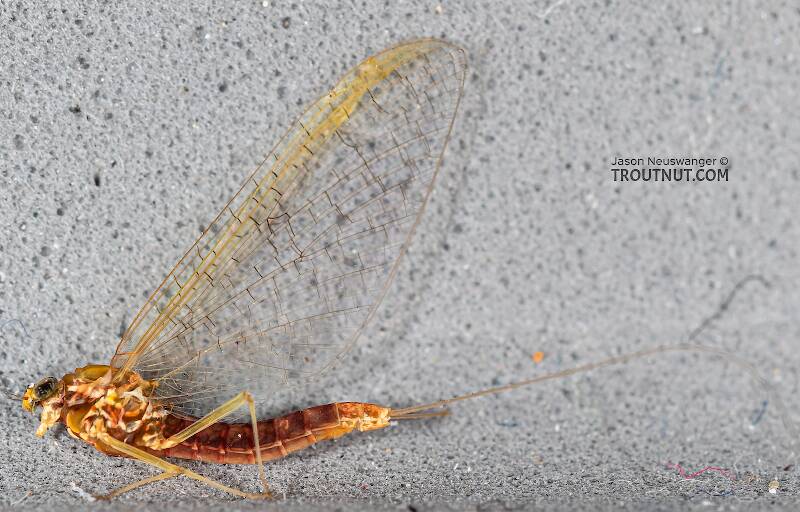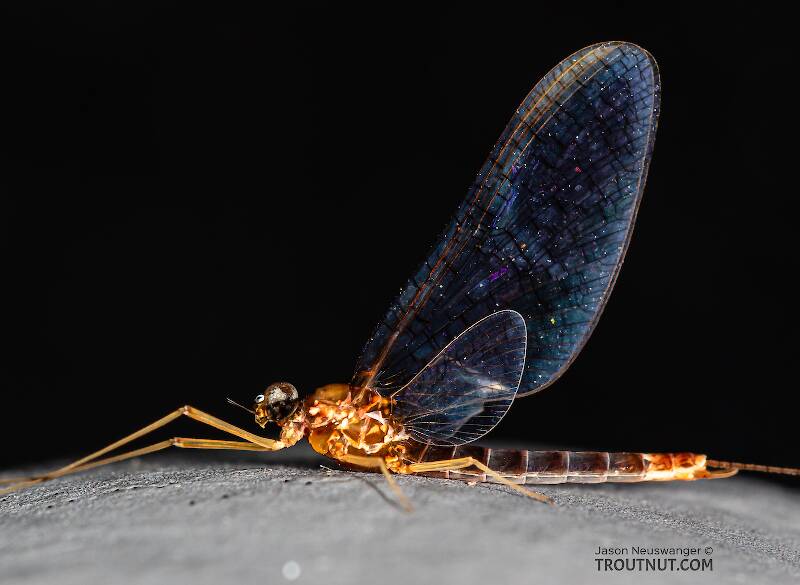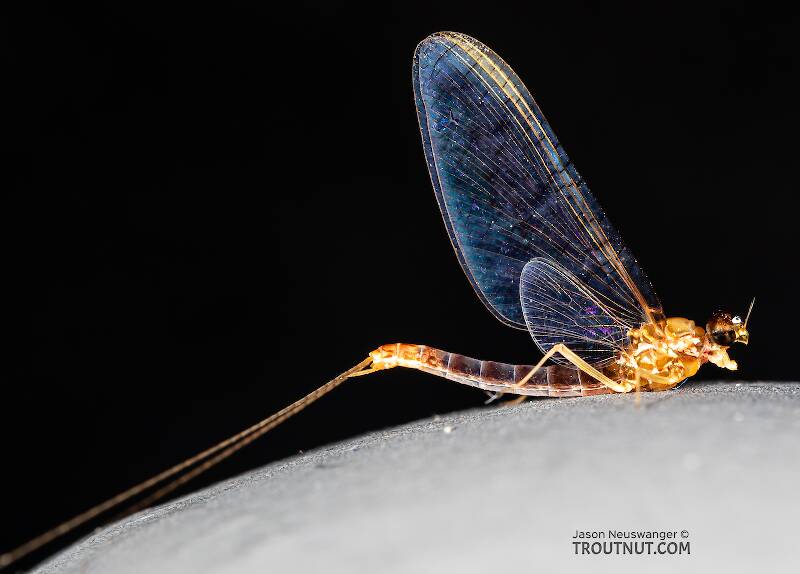
Hex Mayflies
Hexagenia limbata
The famous nocturnal Hex hatch of the Midwest (and a few other lucky locations) stirs to the surface mythically large brown trout that only touch streamers for the rest of the year.


Mayfly Species Cinygmula par
Species Range
Spinner behavior
Time of day: Dusk
Habitat: Riffles
Physical description
Most physical descriptions on Troutnut are direct or slightly edited quotes from the original scientific sources describing or updating the species, although there may be errors in copying them to this website. Such descriptions aren't always definitive, because species often turn out to be more variable than the original describers observed. In some cases, only a single specimen was described! However, they are useful starting points.
Male Spinner
Wing length: 9-10 mm
A medium-sized species, wings tinged with light grey, darker at bases; dark midventral ganglionic marks.
Thoracic notum light pitch-brown, “sometimes approaching light luteo-piceous anteriorly at the sides” (Eaton). Legs sooty to golden brown; base of fore femur and trochanter somewhat paler, base of first fore tarsal joint darker. Wings hyaline, “tinted with light bistre-grey throughout, but with a stronger tint than elsewhere” at the wing roots and in the stigmatic area; near wing roots the color becomes rather dark brown. Venation yellowish brown.
Abdominal segments 2-7 semi-hyaline; tergites largely light brown, the anterior margins, antero-lateral areas, narrow median line and submedian streaks being hyaline, “dirty-whitish.” The three pale longitudinal streaks are outlined in darker color. Sternites paler, the ganglionic areas on 3-7 conspicuously marked with sepia-brown. Segments 8-10 opaque; tergites “Vandyke-brown,” sternites “very light brownish ochre” (Eaton). Tails brown. A large spine on lower outer margin of penes on each side, smaller spine on inner margin (see fig. 103).
This species is allied to both C. confusa and C. hyalina (both now a synonym of C. par), also to the eastern C. atlantica (now a synonym of Cinygmula subaequalis). Distinguishing features are indicated under each of these species.
Described as C. confusa
Body length 9 mm, wing length 10 mm
A rather large species with amber-tinged wings; spines on inner and lower outer margins of penes; purplish mid-ventral patches on hyaline segments.
Head deep red-brown. Thorax light olive brown, the central portion of notum shaded with darker brown; purplish tinges on prothorax, and on pleura below the wings. Coxae of all legs light brown. Fore femur deep purplish, remainder of fore leg blackish; middle and hind legs light purplish brown. Wings “evenly suffused with deep amber color, with dark, clean cut venation” (McD.). Abdominal segments 2-7 hyaline. Posterior half of each tergite purplish brown; indistinct pale submedian streaks outlined in brown are most evident on tergites 2 and 3; on these tergites also, the brown band is wider than on the following segments. Sternites 2-7 with midventral purplish patches, one on each segment. Segments 8-10 opaque, light brown; tergites with slight purplish shading; sternites somewhat paler than tergites. Forceps smoky brown basally; tails deep blackish brown. A spine on inner margin, another on lower outer margin of each side of penes (see fig. 103).
This species is allied to C. hyalina (now a synonym for C. par) and Cinygmula par. The deep amber tinge of the wings distinguishes it from both of these species. The purplish tinge of the fore femur likewise separates it from C. hyalina; the fore leg of C. par is much lighter in color.
Described as C. hyalina
Body length 9? mm, wing length 10? mm
A species with untinted wings; spines on inner and lower outer margins of penes.
The description of this species is largely comparative, with only points of distinction between this and C. confusa (now a synonym of C. par) being indicated. Said to be very similar to confusa in general appearance, but with hyaline wings, tinted very slightly in the stigmatic area only. Thorax somewhat deeper in color than in confusa; legs light to deep brown, but lacking the purple tinge of that species. Tergites 2 and 3 almost entirely brown, with faint traces only of the pale submedian streaks. Posterior margins of tergites brown, with less purplish tinges, and the “definition between the pale and dark areas is less distinct” (McD.). Sternites suffused with whitish, appearing more opaque than in confusa. Penes very similar in structure, but the basal spine on the lower outer margin is relatively longer and straighter, and the divisions of the penes relatively stouter, than in C. confusa. (See fig. 103).
This species is allied also to C. par, from which it may be distinguished by the paler wings and less extensive brown shading on abdominal tergites.
Specimens of the Mayfly Species Cinygmula par
2 Male Spinners
1 Female Spinner

1 Video of Cinygmula par Mayflies:
It's remarkable what thick hatches, and especially spinner flights, can come from a species few anglers have ever heard of. The genus Cinygmula is thought to produce unremarkable spinner flights, but this one would certainly have gotten the trout going if it weren't happening just before dark on a small stream where there isn't a lot of nocturnal feeding.
Start a Discussion of Cinygmula par
References
- Needham, James G., Jay R. Traver, and Yin-Chi Hsu. 1935. The Biology of Mayflies. Comstock Publishing Company, Inc.
Mayfly Species Cinygmula par
Species Range
Resources
- NatureServe
- Integrated Taxonomic Information System
- Global Biodiversity Information Facility
- Described by Eaton (1885)



